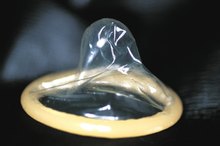Causes of Thick Mucus During Your Period
Women often refer to the discharge in a menstrual cycle as mucus. This mucus normally changes consistency throughout the menstrual cycle and is odorless. The discharge comes from the cervical glands as a way to keep the vagina clean and moisturized. Although discharge can be abundant, vaginal discharge with an odor is not normal.
If you are experiencing serious medical symptoms, seek emergency treatment immediately.
Ovulation
Ovulation is a process that occurs midway through the menstrual cycle. The process occurs when an egg is released from a follicle that has been maturing the egg, within the ovary. To prompt the release, the pituitary gland secretes a high level of the luteinizing hormone, which then causes levels of the hormones estrogen and progesterone to rise. Normally, a woman produces discharge at all stages of her menstrual cycle, with a consistency that is normally watery or sticky and white. However, around the time of this hormonal surge, the vaginal discharge becomes clear and stretchy and will be more abundant than any other discharge within the menstrual cycle. This is considered a woman’s most fertile time, according to Ovulation-calculator 1.
- Ovulation is a process that occurs midway through the menstrual cycle.
- However, around the time of this hormonal surge, the vaginal discharge becomes clear and stretchy and will be more abundant than any other discharge within the menstrual cycle.
Bacterial Vaginosis
Causes of Whitish Yellowish Vaginal Discharge
Learn More
According to the Centers for Disease Control and Prevention, bacterial vaginosis--BV--is a condition that causes a disruption in the normal balance of bacteria within the vagina, leading to the overgrowth of a certain bacteria 3. BV is considered one of the most common vaginal infections in women of childbearing age. According to the CDC, bacterial vaginosis is common among pregnant women in the U.S. Doctors aren’t sure what causes BV or exactly how it develops, but they have found that having multiple sex partners or douching may increase the risk of getting it. Symptoms of BV are thin, white or grey vaginal discharge with a bad odor, fish-like smell after sex and burning or itching around the vagina.
- According to the Centers for Disease Control and Prevention, bacterial vaginosis--BV--is a condition that causes a disruption in the normal balance of bacteria within the vagina, leading to the overgrowth of a certain bacteria 3.
- According to the CDC, bacterial vaginosis is common among pregnant women in the U.S. Doctors aren’t sure what causes BV or exactly how it develops, but they have found that having multiple sex partners or douching may increase the risk of getting it.
Vaginal Yeast Infection
Vaginal yeast infections are experienced by 75 percent of women at some point in their lives, according to Women’s Health. A vaginal yeast infection is caused by the overgrowth of a fungus called candida. Vaginal yeast infections can be caused by stress, lack of sleep, pregnancy, eating too much sugar, uncontrolled diabetes, HIV/AIDS and hormonal changes during the menstrual period.cause:
- Vaginal yeast infections can be caused by stress
- lack of sleep
- pregnancy
- eating too much sugar
- uncontrolled diabetes
- HIV/AIDS
- hormonal changes during the menstrual period
Yeast infections are normally cured by using vaginal creams, ointments or suppository pills.
Related Articles
References
- Ovulation-calculator: Cervical Mucus
- Centers for Disease Control and Prevention: Bacterial Vaginosis
- Miller EA, Beasley DE, Dunn RR, Archie EA. Lactobacilli Dominance and Vaginal pH: Why Is the Human Vaginal Microbiome Unique? Front Microbiol. 2016;7:1936. doi:10.3389/fmicb.2016.01936
- Godha K, Tucker KM, Biehl C, Archer DF, Mirkin S. Human vaginal pH and microbiota: an update. Gynecol Endocrinol. 2018;34(6):451-455. doi:10.1080/09513590.2017.1407753
- Amabebe E, Anumba DOC. The Vaginal Microenvironment: The Physiologic Role of Lactobacilli. Front Med. 2018;5:181. doi:10.3389/fmed.2018.00181
- Watson CJ, Grando D, Garland SM, Myers S, Fairley CK, Pirotta M. Premenstrual vaginal colonization of Candida and symptoms of vaginitis. J Med Microbiol. 2012;61(Pt 11):1580-1583. doi:10.1099/jmm.0.044578-0
- Paladine HL, Desai UA. Vaginitis: Diagnosis and Treatment. Am Fam Physician. 2018;97(5):321-329.
- Martin Lopez JE. Candidiasis (vulvovaginal). BMJ Clin Evid. 2015:0815
- Hay P. Bacterial vaginosis. F1000Res. 2017;6:1761. doi:10.12688/f1000research.11417.1
- Paladine HL, Desai UA. Vaginitis: Diagnosis and Treatment. Am Fam Physician. 2018;97(5):321-329.
- Qin F, Wang Q, Zhang C, et al. Efficacy of antifungal drugs in the treatment of vulvovaginal candidiasis: a Bayesian network meta-analysis. Infect Drug Resist. 2018;11:1893-1901. doi:10.2147/IDR.S175588
- Chavoustie SE, Jacobs M, Reisman HA, et al. Metronidazole vaginal gel 1.3% in the treatment of bacterial vaginosis: a dose-ranging study. J Low Genit Tract Dis. 2015;19(2):129-134. doi:10.1097/LGT.0000000000000062
Writer Bio
April Khan is a medical journalist who began writing in 2005. She has contributed to publications such as "BBC Focus." In 2012, Khan received her Doctor of Public Health from the University of Medicine and Dentistry of New Jersey. She also holds an Associate of Arts from the Art Institute of Dallas and a Master of Science in international health from University College London.








